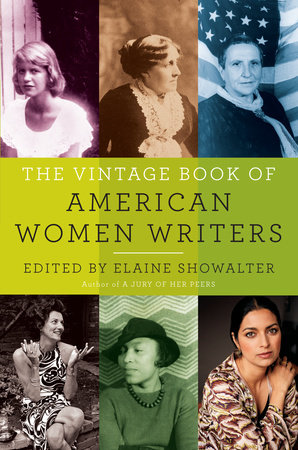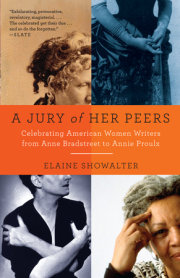Introduction by Elaine Showalter
The Mothers of Us allSince they first began to appear in print over 350 years ago, American women writers have publicly insisted that they did not care about literary fame or immortality. Anne Bradstreet, whose book
The Tenth Muse Newly Sprung Up in America was published in 1650, declared that she was contented with her humble domestic niche as a Puritan housewife and mother, and denied any interest in winning the laurel wreath or other poetic awards. If men did her the honor of reading her poems, she wrote, "Give thyme or parsley wreath, I ask no bays." In other words, Bradstreet was content to be the Poet Parsleyate, rather than the Poet Laureate, and her imagery of the kitchen of Parnassus would be echoed by many American women writers who came after her.
Hoping for fame seemed unfeminine and self-aggrandizing, and they denied that such ambition inspired them to write. Rather than admitting their own ambitions, promoting their own creativity, or claiming their place in their nation's literary history, the founding mothers of American literature were more likely to avoid publicity and to deprecate their own achievements. They published anonymously or under a pseudonym, and they wrote conflicted accounts of their own longings to write. Lydia Maria Child signed her first novel,
Hobomok (1824), "By an American"; she had been warned "that no woman could expect to be regarded as a
lady after she had written a book." Child ruefully noted in her diary that for Christmas her husband had given her a laurel wreath, but "the leaves . . . were not very abundant."
When reviews of their works were scanty or harsh, women writers suffered in silence. But American male writers were more forthright and enterprising. When
Leaves of Grass received only a handful or horrified reviews, Walt Whitman reviewed it himself—anonymously—as a work of genius by a true "American bard." Meanwhile, his great contemporary, Emily Dickinson, steadfastly refused to publish more than a handful of her poems during her lifetime.
Yet American women writers also believed that they were fully equal to the challenge of creating an American literature for a new nation. Women's rights and women's writing were closely allied after the Declaration of Independence. In 1792, Judith Sargent Murray wrote that women "were equally susceptible of literary acquirement," and envisaged herself "supplying the American stage with American scenes." Child and her generation of writers dedicated themselves to literature of their "native land." They shared common themes as well individual genius. From the beginning, they wrote with sympathy about the outcast, the slave, the Native American, the madwoman. They wrote dark fables about marriage. Over the centuries, they wrote both directly and figuratively about female experience and female sexuality, from abortion to menopause. They were fascinated by the images of the circus, the carnival, and the freak in relation to the situation of the odd woman and the artist. But they also wrote about male experience and, from the masculine perspective, about cowboys, ranchers, soldiers, boxers, and killers. The range of women's writing is much wider in subject and style than is generally supposed.
However, even when they were praised and celebrated in their own day, whether as bestsellers like Harriet Beecher Stowe or Nobel Prize-winners like Pearl Buck, American women writers have tended to disappear from literary history and national memory. I explore the multiple reasons for this phenomenon in my book,
A Jury of Her Peers: American Women Writers from Anne Bradstreet to Annie Proulx. But the main reason women do not figure in American literary history is because they have not been the ones to write it. And in the twenty-first century, we need historical chronology, literary contexts, and the sense of continuity as steps toward doing the fullest justice to American women's writing. We need a sense of chronology to see how women writers fit on the literary timeline of American literature, to understand them as belonging to and affecting literary traditions, and not simply as isolated and exceptional women who popped up from time to time. We need to see women writers in context, placed in relation to their contemporaries and their precursors. Finally, we need a canon of outstanding women writers over the past four centuries both to organize their history and to begin the arguments that keep literary discussion alive.
I intend this anthology both as a companion to
A Jury of Her Peers, making available works by important American women writers from 1650 to the present; and also as a portable and readable introduction to the literary mothers of us all. Obviously it cannot claim to be comprehensive. I have had to leave out many great women novelists because of limitations of space, and some contemporary writers because of the expense of copyright permission. But
The Vintage Book of American Women Writers is a collection of wonderful stories, essays, fables, and poems by a remarkable group of writers who have shaped our literary heritage.
Copyright © 2011 by Edited with an Introduction by Elaine Showalter. All rights reserved. No part of this excerpt may be reproduced or reprinted without permission in writing from the publisher.









